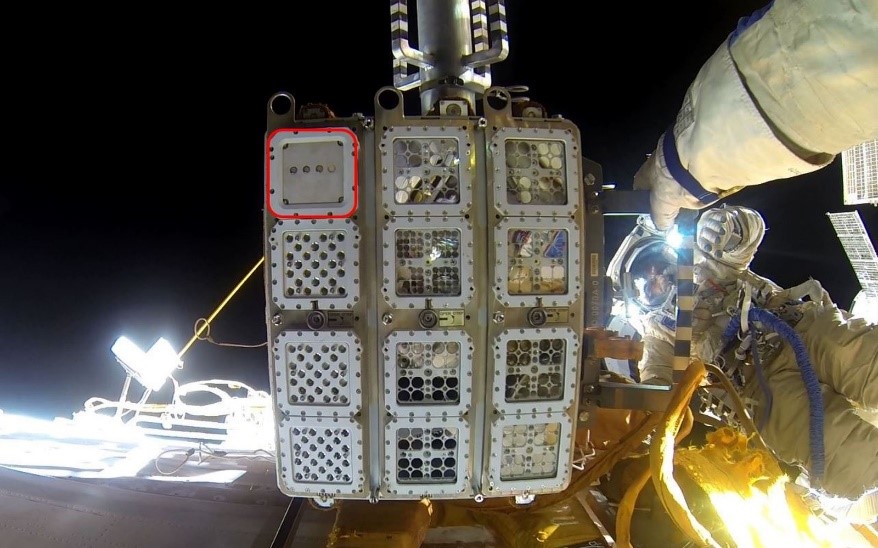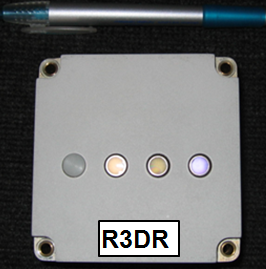R3DR2, Inside ESA EXPOSE-R2, Outside “Zvezda” module of ISS
Satellite provider: Roscosmos
Satellite name: ISS, Zvezda module
Experiment name: ESA, EXPOSE-R2
Instrument name: R3DR2
Cooperation: Bulgaria, Germany
Begin-end of data: 23/10/2014-10/01/2016
PI/CoPI: G. Horneck, DLR; D. Häder, UE; Ts. Dachev, SRTI
Main description Reference: (Dachev et al., 2017), https://doi.org/10.1002/2016SW001580
Units: Size [mm]/Mass [kg]: 1 DU (76x76x36 mm, 0.17 kg)
Place: Outside of ISS, outside Zvezda module, in the EXPOSE-R2 facility. (Please see figure below).
Shielding [g cm-2]: >0.3 g cm-2
Resolution [sec]/[min]: 10 s

External view of EXPOSE-R2 facility and R3DR2 instrument (in the red square)

External view of R3DR2 instrument
(Note: The R3DR2 spectrometer-dosimeter onboard the “Zvezda” module of ISS is the same instrument as flown in the EXPOSE-R facility from 2009-2010, which was called R3DR, but here is given the extension R2 to distinguish between the data from the previous mission.)

Block-diagram of R3DR2 instrument.
The semiconductor detector of the R3DR2 instrument was mounted approximately 7 mm below the 0.8 mm thick aluminium cover plate. Furthermore, there was shielding from 0.07 mm copper and 0.2 mm plastic, which provided 0.3 g cm-2 of total shielding from the front side. The calculated required kinetic energy of particles arriving perpendicular to the detector was 0.835 MeV for electrons and 19.5 MeV for protons (Berger et al., 2017). This means that only electrons and protons with energies exceeding the values listed above can cross the R3DR2 shielding materials and reach the detector surface. The detector shielding, being larger from the sides and from behind (Fig. 1), stops all ORB relativistic electrons, attenuates the lower energy IRB protons, but practically does not change the amount of GCR particles.
Dose measurement algorithms and formulas
The main measured parameter in the R3DR2 instrument is the amplitude of the pulse after the CSA, generated by a particle or a photon partially or fully crossing the detector (Dachev et al., 2002). The amplitude of the pulse is proportional by a factor of 240mV/MeV to the energy deposited in the detector and to the dose, respectively. These amplitudes are digitized in an 8-bit ADC and organized in a 256-channel deposited energy spectrum.
By definition the dose in the silicon detector DSi [Gy] is one joule deposited in 1 kg of matter. The MDUs absorbed dose is calculated by dividing the summarized energy deposition in the spectrum in joules by the mass of the detector in kilograms:

where K is a coefficient, MD is the detector sensitivity area mass and Eli is the energy deposition in Joules in channel i. The energy in MeV is proportional to the amplitude A of the pulse: Eli [MeV] =A [V]/0.24 [V/MeV], where 0.24 [V/MeV] is a coefficient dependent on the preamplifier used and its sensitivity.
All 255 deposited dose values, depending on the deposited energy for one exposure period, form the deposited energy spectrum. Channel 256 accumulates all pulses with amplitudes higher than the upper energy of 20.83MeV measured by the spectrometer. The methods for characterization of the type of incoming space radiation are described in Dachev (2009), http://dx.doi.org/10.1016/j.asr.2009.08.007; and Dachev et al. (2017), https://doi.org/10.1002/2016SW001580.
The following four primary radiation sources were expected and recognized in the data obtained with the R3DR2 instrument: (i) globally distributed primary GCR particles and their secondary products; (ii) protons in the SAA region of the IRB*; (iii) relativistic electrons and/or bremsstrahlung in the high latitudes of the ISS orbit where the ORB is situated; and (iv) solar energetic particles (SEP) in the high latitudes of the ISS orbit. Together with the real SEP particles, a low flux of what were likely to be mostly secondary particles (SP) (protons, neutrons and heavier than H+ ions) some of them associated with detector interactions were observed in the data. (Neutrons was registered because the “neutron induced nuclear counter effect” described for silicon PIN diodes of Hamamatsu S2744-08 type by Zhang et al. (2011), 10.1109/TNS.2011.2132144. The result of the selection was shown in column 3 (ST) of the csv format files with meanings (GCR, IRB, ORB, SEP).
*Remarks:
1) 0.63% (1607 points from totally 254,381 IRB points) situated outside SAA were selected by the software as IRB point source. Simple requirements for B>0.24 will remove them from any IRB source separation;
2) On January 14, 2015 between 9:16:14 and 12:28:11 UT were recorded disturbances in the IRB source, which generated in 59 spectra high count rates and respectively flux rate in 5 channels: 242, 243, 253, 254 and 256. The counts number in channel 253 are fixed for all occurrences at 13,138 counts. The signals (not noise) are distributed over the 2.5 orbits and disappear. There is no explanation of the nature of the signals.
“DATA SOURCES” string description
UT date and time (DD/MM/YYYY hh:mm:ss); UT (hh:mm:ss); source type ST (GCR, IRB, ORB, SEP); ALT (altitude (km); longitude (deg); latitude (deg); L value; total magnetic field strength B (Gauss); LT (hours); MLT (hours); DIPL dip latitude (deg); INLAT invariant latitude (deg); F flux (1/cm2 s); D absorbed dose rate (µGy/hour); D/F (nGy cm2 particle-1); PE proton energy (MeV) (PE is calculated from the Hefner’s formula for the defined D/F value); H* total apparent ambient dose equivalent rate H*(10) (µSv/hour), H*l calculated low energy component of H*(10)low (µSv/hour); H*h high energy component of H*(10)high (µSv/hour); ch1-ch255 values of the count rate in the deposited energy spectrum.
All R3DR2 full text data are separated in 44 10 days files. All full text files are in csv format.
Link to the full text “DATA SOURCES” files: http://esa-pro.space.bas.bg/node/23 or http://esa-pro.space.bas.bg/datasources/R3DR2
Additional references, concerning R3DR2 data:
Dachev, T.P., B. T. Tomov, Yu. N. Matviichuk, Pl. G. Dimitrov, N.G. Bankov, D.-P. Häder, G. Horneck, G. Reitz, ISS radiation environment as observed by Liulin type-R3DR2 instrument in October-November 2014, Aerospace Research in Bulgaria, 27, 17-42, 2015, http://www.space.bas.bg/Aerospace%20research/27/2.pdf
Dachev, T.P., J.V. Semkova, B.T. Tomov, Yu.N. Matviichuk, Pl.G. S. Maltchev, R. Koleva, Pl., Dimitrov, N.G. Bankov, V.V., Shurshakov, V.V., Benghin, E.N., Yarmanova, O.A. Ivanova, D.-P. Häder, M.T. Schuster, G. Reitz, G. Horneck, Y. Uchihori, H. Kitamura, O. Ploc, J. Kubancak, I. Nikolaev, Overview of the Liulin type instruments for space radiation measurement and their scientific results, 92–114, 2015. http://dx.doi.org/10.1016/j.lssr.2015.01.005
Dachev, T.P., B. T. Tomov, Yu. N. Matviichuk, Pl. G. Dimitrov, N.G. Bankov, High dose rates obtained outside ISS in June 2015 during SEP event, Life Sciences in Space Research, 9, 84-92, 2016, http://dx.doi.org/10.1016/j.lssr.2016.03.004
Dachev, T.P, N.G. Bankov, B. T. Tomov, Y. N. Matviichuk, P. G. Dimitrov, D.-P. Häder, G. Horneck, Overview of the ISS radiation environment observed during EXPOSE-R2 mission in 2014-2016, Paper presented at 21st Workshop on Radiation Measurements on ISS, ESTEC, Noordwijk, The Netherlands, 6-8 September 2016, http://wrmiss.org/workshops/twentyfirst/Dachev_EXPOSE.pdf.
Dachev, T. P., N. G. Bankov, G. Horneck, D.-P. Häder; Letter to the Editor. Radiat Prot. Dosimetry, 174 (2), 292-295, 2017, https://doi.org/10.1093/rpd/ncw123
Dachev, T. P., Bankov, N. G., Tomov, B. T., Matviichuk, Y. N., Dimitrov, P. G., Häder, D.-P. & Horneck, G. (2017). Overview of the ISS radiation environment observed during the ESA EXPOSE-R2 mission in 2014–2016. Space Weather, 15. https://doi.org/10.1002/2016SW001580
Dachev, T. P., Relativistic Electron Precipitation Bands in the Outside Radiation Environment of the International Space Station, Journal of Atmospheric and Solar-Terrestrial Physics, 2017. https://doi.org/10.1016/j.jastp.2017.11.008
Dachev, T.P., N.G. Bankov, B. T. Tomov, Yu. N. Matviichuk, Pl. G. Dimitrov, Earth magnetic field activity induced variations of the ISS inner radiation belt SAA region, Paper presented at 22nd Workshop on Radiation Measurements on ISS, Thales Alenia Space, Torino, Italy, 5–7 September 2017. http://www.wrmiss.org/workshops/twentysecond/Dachev_SAA.pdf
Dachev, T. P., South-Atlantic Anomaly Magnetic Storms Effects as Observed outside the International Space Station in 2008-2016, Journal of Atmospheric and Solar-Terrestrial Physics, 2018. (Under evaluation)
Please acknowledge data provider:
Tsvetan Dachev, SRTI-BAS tdachev@bas.bg or: tdachev59@gmail.com
URL: http://scholar.google.com/citations?user=uzmW_mwAAAAJ
